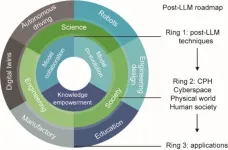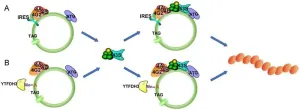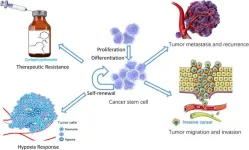(Press-News.org)
A recent paper published in the journal Engineering delves into the future of artificial intelligence (AI) beyond large language models (LLMs). LLMs have made remarkable progress in multimodal tasks, yet they face limitations such as outdated information, hallucinations, inefficiency, and a lack of interpretability. To address these issues, researchers explore three key directions: knowledge empowerment, model collaboration, and model co-evolution.
Knowledge empowerment aims to integrate external knowledge into LLMs. This can be achieved through various methods, including integrating knowledge into training objectives, instruction tuning, retrieval-augmented inference, and knowledge prompting. For example, some studies design knowledge-aware loss functions during pre-training, while others use retrieval-augmented generation to dynamically fetch relevant knowledge during inference. These techniques enhance LLMs’ factual accuracy, reasoning capabilities, and interpretability.
Model collaboration focuses on leveraging the complementary strengths of different models. It includes strategies like model merging and collaboration based on different functional models. Model merging, such as model ensembling and model fusion (e.g., the mixture of experts), combines multiple models to improve performance. In functional model collaboration, LLMs can act as task managers, coordinating specialized small models. For instance, in image-generation tasks, LLMs can guide specialized models to better meet the requirements of prompts.
Model co-evolution enables multiple models to evolve together. Under different types of heterogeneity-model, task, and data-various techniques have been proposed. For model heterogeneity, methods like parameter sharing, dual knowledge distillation, and hypernetwork-based parameter projection are used. In the face of task heterogeneity, dual learning, adversarial learning, and model merging play important roles. When dealing with data heterogeneity, federated learning and out-of-distribution knowledge distillation are key techniques. These methods enhance models’ adaptability and ability to handle diverse tasks.
The post-LLM advancements have far-reaching impacts. In science, they help in hypothesis development by incorporating domain-specific knowledge. For example, in meteorology, AI models integrated with domain knowledge can improve renewable energy forecasting. In engineering, they assist in problem formulation and solving. In society, they can be applied in areas like healthcare and traffic management.
Looking ahead, the paper also points out several future research directions, including embodied AI, brain-like AI, non-transformer foundation models, and LLM-involved model generation. These areas hold great potential for further advancing AI capabilities. As AI continues to evolve, the integration of knowledge, collaboration, and co-evolution will be crucial in building more robust, efficient, and intelligent AI systems.
The paper “Knowledge-Empowered, Collaborative, and Co-Evolving AI Models: The Post-LLM Roadmap,” authored by Fei Wu, Tao Shen, Thomas Bäck, Jingyuan Chen, Gang Huang, Yaochu Jin, Kun Kuang, Mengze Li, Cewu Lu, Jiaxu Miao, Yongwei Wang, Ying Wei, Fan Wu, Junchi Yan, Hongxia Yang, Yi Yang, Shengyu Zhang, Zhou Zhao, Yueting Zhuang, Yunhe Pan. Full text of the open access paper: https://doi.org/10.1016/j.eng.2024.12.008. For more information about the Engineering, follow us on X (https://twitter.com/EngineeringJrnl) & like us on Facebook (https://www.facebook.com/EngineeringJrnl).
END
Tokyo, Japan – The XRISM collaboration have discovered flows of hot gas in the core of the Centaurus Cluster. By comparing state-of-the-art X-ray measurements from the XRISM satellite with numerical simulations, they showed this is evidence for collisions between galaxy clusters, causing gas inside to “slosh”. This solves the longstanding mystery of how cluster cores stay hot, and sheds light on how our universe continues to evolve.
Astronomers have long envisioned how vast gravitational forces ...
Incidents of children in the U.S. being poisoned by the synthetic opioid fentanyl “increased and became more severe”, a new study reveals.
Launched today as Congress continues to review the HALT Fentanyl Act, the research follows an analysis of nonfatal fentanyl pediatric (aged 0-19) exposures reported to poison centers in 49 U.S. states from 2015 through to 2023.
In total, some 3,009 cases were detailed across the eight-year period.
In 2023 alone, 44.6% were life-threatening incidents in which there was extreme harm ...
Humans may not be the only ones who aid their friends when they’re hurt. Mice may do it, too, as shown by a new research study led by scientists at the Keck School of Medicine of USC published recently in Science.
Scientists have been trying to understand why social mammals appear to help injured members of their species. There are numerous factors that determine empathetic behavior and social bonding in mammals, said Li Zhang, the principal investigator of the study and professor of physiology and neuroscience ...
An ambitious project led by Vanderbilt University Medical Center investigators aims to use artificial intelligence technologies to generate antibody therapies against any antigen target of interest.
VUMC has been awarded up to $30 million from the Advanced Research Projects Agency for Health (ARPA-H) to build a massive antibody-antigen atlas, develop AI-based algorithms to engineer antigen-specific antibodies, and apply the AI technology to identify and develop potential therapeutic antibodies.
ARPA-H is an ...
A new review article highlights the transformative role of circular RNA (circRNA) in cancer, revealing its potential as both a key player in tumor biology and a promising avenue for future therapies. Once thought to be noncoding RNA, circRNA has now been shown to encode functional proteins, challenging conventional RNA biology and opening up novel therapeutic possibilities.
Unlike traditional messenger RNA, circRNAs form a continuous loop, lacking the typical 5' cap and 3' tail. This unique structure was originally believed to preclude them from protein translation. However, recent discoveries demonstrate that specific internal ribosome entry sites (IRES) and N6-methyladenosine ...
Lung cancer remains one of the leading causes of cancer-related mortality, with lung adenocarcinoma (LUAD) and lung squamous cell carcinoma (LUSC) representing the most prevalent subtypes of non-small cell lung cancer (NSCLC). Despite their classification under the same umbrella, these two forms of lung cancer exhibit distinct genetic landscapes, therapeutic targets, and treatment responses.
Recent advancements in next-generation gene sequencing have identified key driver genes that differentiate LUAD and LUSC, influencing their respective clinical management approaches. LUAD is frequently associated ...
A study published March 6 in The Lancet Regional Health — Americas highlights a growing divide in cardiovascular health in the U.S., showing that wealth and education play a significant role in heart disease risk.
The research, led by Salma Abdalla, MBBS, DrPH, an assistant professor of public health at Washington University in St. Louis, reveals that the top 20% of high-income, college-educated Americans have far lower rates of cardiovascular disease than the rest of the population — disparities ...
This review highlights the critical role of ubiquitination in governing the functionality of cancer stem cells (CSCs), shedding light on potential therapeutic targets for combating tumor progression, recurrence, and drug resistance. Published in Genes & Diseases, this article explores the intricate mechanisms through which the ubiquitin (Ub) system regulates key pathways essential for CSC maintenance and survival.
Ubiquitination, a fundamental post-translational modification, plays a pivotal role in protein stability, cellular signaling, and gene expression, particularly in the context of CSCs. Dysregulation ...
A new review highlights the pivotal role of LSD1 (lysine-specific demethylase 1) in regulating critical cellular processes and its implications for human diseases. This article sheds light on how post-translational modifications (PTMs) influence LSD1 activity, impacting its function in gene regulation and disease progression.
LSD1 is a histone demethylase that plays a significant role in chromatin remodeling and gene expression by modifying histone H3 lysine residues. It interacts with various protein complexes, allowing it to serve as both a transcriptional activator and repressor. The intricate modifications ...
Surgeons and teams with Vanderbilt Lung Transplant performed 99 lung transplants in 2024, the most ever in one year. Two of the procedures involved combined organ transplants.
For the second calendar year in a row, Vanderbilt Lung Transplant has the busiest program in the Southeast and leads the nation in innovation in organ preservation and regeneration.
The Vanderbilt Transplant Center is now home to the nation’s eighth largest lung transplant program by volume, and is among the best in long-term outcomes, demonstrating the ...







